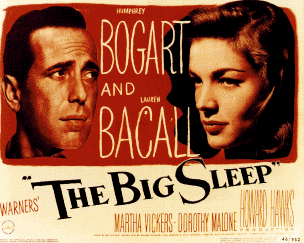

'I'm a licensed private investigator and have been for quite a while. I'm a lone wolf, unmarried, getting middle-aged, and not rich. I've been in jail more than once and I don't do divorce business. I like liquor and women and chess and a few other things. The cops don't like me too well, but I know a couple I get along with. I'm a native son, born in Santa Rosa, both parents dead, no brothers or sisters, and when I get knocked off in a dark alley sometime, if it happens, as it could to anyone in my business, nobody will feel that the bottom has dropped out of his or her life.'
Quite a character to have as your moral centre. Yet this is what Philip Marlowe is in Raymond Chandler's novels: he works to discover the truth, who killed who, why and will they do it again. In The Big Sleep, the first story featuring Marlowe, we follow our detective as he investigates a blackmailer who is targeting the wild daughters of General Sternwood. The book was released in 1939, with Howard Hawks' film adaptation following in 1946. The novel is a hardboiled crime novel, which translates into a film noir on the screen.
The starkest difference between Hawks' film and Chandler's novel is the relationship between Marlowe and Mrs Vivian Regan (in the film Vivian Rutledge), General Sternwood's oldest daughter. In the book Marlowe interacts with her about four times in total: at the Sternwood house, his office, the gambling house and once again at her home. The movie includes Vivian in more scenes, and even creates one at a restaurant. There is an obvious answer to this: the studio wanted to capitalise on the chemistry and notoriety of Humphrey Bogart and Lauren Bacall, who played Marlow and Vivian.
 The chemistry is there in spades, particularly in the restaurant scene and later in a car. Bogie and Bacall spark off each other, but there is also a genuine sense of affection: they care for each other. In the novel, while Vivan does try to seduce Marlowe, he carefully rebuffs her (after accepting a few kisses). This change in their relationship drastically changes the outcome of the story and the projection of Marlowe's character.
The chemistry is there in spades, particularly in the restaurant scene and later in a car. Bogie and Bacall spark off each other, but there is also a genuine sense of affection: they care for each other. In the novel, while Vivan does try to seduce Marlowe, he carefully rebuffs her (after accepting a few kisses). This change in their relationship drastically changes the outcome of the story and the projection of Marlowe's character.Marlowe ends Chandler's novel feeling wistful not for Vivian, but rather Mona Mars, the beautiful woman that has been missing for most of the novel. The last line of The Big Sleep is 'All they [the alcoholic drinks] did was make me thin of Silver-Wig, and I never saw her again.' There is a great bitterness and sadness in this line. Marlowe has something of the courtly knight about him; his quest is always to uncover the truth, and he occasionally becomes attached to the women caught up in the plots. Mona 'Silver-Wig' Mars was a bit of a damsel in distress, and Marlowe's sense of decency responded to her.
This is the last shot of the film:
Marlowe isn't so alone now, is he! Not only is Vivian with Marlowe at the end, she is the one who saves him from Canino, not Mona Mars (who is there but leaves in a huff after Marlowe says some nasty things about her husband). The love scene in the car is more romantic than in the novel as well; it is not simply an exchange of sleazy kisses but sincere declarations of love.
The result of this change is that Marlowe changes as a character during the film. He begins as the cynical Marlowe from Chandler's novel, but at the end has found love with another. They both know the truth about each other and rather than being repulsed, are actually drawn together. Chandler's Marlowe ends the novel perhaps even more jaded than at the beginning; most of his views of life have been reinforced, not challenged.
The reason for this change is down to both the audience expectation. As previously mentioned, Bogie and Bacall were famous for their chemistry, and the audience would have wanted to see them together at the end, just as they were in their first film together To Have and Have Not (1944). It is interesting to note that nowdays audiences would protest at such a pandering alteration being made to such a great book. However, this change allows the two texts to stand on their own and be enjoyed separately. The novel is a great piece of hardboiled fiction, the film a great example of film noir.
Do you agree? Can a film change enough of the story to be its own text, or are you a purist?


I love the novel (I've read it three times), and I love the movie (I bet I've seen it ten times). There are differences, but the most important mystery always remains at the heart of both versions:
ReplyDeleteWho killed the chauffer?!?!
(Last year, I read the book carefully and noted all references to the chauffer, and I did the same for the movie. I think it's pretty clear in both that Marlowe thinks the chauffer killed himself.)